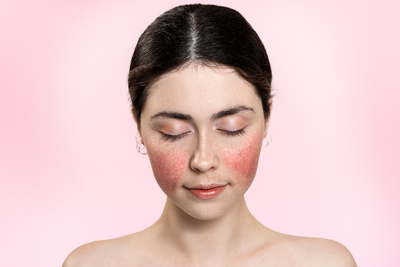All About Rosacea: Triggers, Treatments and Tips for this Chronic Skin Condition
 April is Rosacea Awareness Month. Many people are not aware of how to treat rosacea and often confuse it with redness from irritation or acne breakouts. But there’s a real difference. “It is very important to determine if you have rosacea or acne, because the treatments can be very different,” says Dr. Jeremy Fenton from Schweiger Dermatology Group.
April is Rosacea Awareness Month. Many people are not aware of how to treat rosacea and often confuse it with redness from irritation or acne breakouts. But there’s a real difference. “It is very important to determine if you have rosacea or acne, because the treatments can be very different,” says Dr. Jeremy Fenton from Schweiger Dermatology Group.
“Treatments that may be helpful for acne, which promote exfoliation and may dry the skin, can easily make rosacea much worse.” Additionally, when left untreated, rosacea can potentially cause damage to the eyes (in a condition called ocular rosacea). For this reason, as well as the cosmetic annoyance of redness and bumps on the skin, rosacea should be diagnosed as early as possible.
Here, Dr. Fenton answers some of the most common questions on how to treat rosacea.
What are the latest and most effective treatments for rosacea?
There are some new topical medications that have come out in recent years including:
Zilxi: This is the latest medication to be released for rosacea. It was a major breakthrough, because they were able to create a topical formulation of a common oral antibiotic (minocycline) that is used for rosacea and acne. We know that oral antibiotics such as minocycline work very well for the inflammatory lesions in rosacea, but we also know that there are many downsides to being on antibiotics long-term. Although it may not work as well as a pill, it is a great option for patients who want to stick with topicals instead of an oral medication. The only complaint I have had from some of my patients is that it can leave a slight yellow film on the skin that can stain pillowcases and towels. Otherwise, it is tolerated very well without irritating the skin. Additionally, this is a medication that can help both acne and rosacea. It is available in a stronger percentage designed for acne.
Rhofade: This is one of two medications designed specifically for the redness is Rhofade. For some patients, Rhofade can significantly decrease the redness for about 12 hours. It constricts the blood vessels and produces a temporary effect that lasts most of the day.” Rhofade is an improvement over prior topical treatments designed specifically for redness, because the risk of rebound redness is reduced. There is also some preliminary evidence that long-term use can create a lasting effect that prevents the redness from worsening over time.
Ivermectin cream: A once-a-day topical cream that targets the papules and pustules, it reduces the amount of natural mites that live in the skin and can cause inflammation. It is believed that people with rosacea have higher levels of these mites living on the skin and have a stronger inflammatory response to them.
Finacea: This is the brand name of a medication with the active ingredient azelaic acid, a topical ingredient that has been around for quite some time. This active ingredient was re-released in a new vehicle, a foam, that some is less irritating than some other formulations and may be more effective.
Laser Treatments for Rosacea: Many medications can help the inflammatory papules and pustules of rosacea, but the most effective and long-term solution for the redness are in-office laser treatments. These lasers target the blood vessels at the surface of the skin which are responsible for the redness. I use a combination of different lasers, individualized to the patient’s skin type, goals and tolerance for downtime such as bruising. The pulsed dye laser is usually the most effective, but strong settings can result in bruising. For those who want confidently avoid bruising, I generally choose the KTP laser. This procedure has little downtime, usually just some increased redness for about 24 hours. After three to four treatments, patients usually see a significant reduction in the redness that can last for three to four years.
Antibiotics for Rosacea: Oral options like doxycycline and minocycline have been traditionally used to provide anti-inflammatory benefits. At a lower dose, it can reduce the long-term risks of traditional dosing. Emrosi is the latest antibiotic approved for rosace. It is a low dose, extended-release version of minocycline that can reduce the amount of antibiotics taken per dose. Sarecylcine is a novel antibiotic that was approved in 2018 that can be helpful for acne and rosacea. It’s similar to doxycycline and minocycline, but with a more narrow spectrum of activity.
Should those with rosacea try and tackle it alone or always seek the help of a dermatologist?
It is a good idea to get the help of a dermatologist if you think you suffer from rosacea. Many of the most effective treatment options are only available by prescription. It is also important to determine if you have rosacea or acne, because the treatments can be very different. Treatments that may be helpful for acne which promote exfoliation and may dry the skin, can easily make rosacea much worse. Rosacea can also affect the eyes, called ocular rosacea. This left untreated can potentially cause damage to the eyes and should be diagnosed as early as possible.
What are the best lifestyle modification to get rosacea under control?
 The redness and flushing that comes with rosacea can be worsened by certain factors that patients can control. Rosacea patients should get to know their triggers and avoid them. Common triggers include spicy foods, alcohol, hot drinks, and large changes in temperature. Patients should always use a sunscreen as well, because chronic sun exposure will increase that persistent redness and make prominent blood vessels more visible. Patients with rosacea should use gentle cleansers and avoid anything that may irritate the skin, which can bring out more inflammation. For basic moisturizers and facial washes, I recommend products designed for sensitive skin such as Cetaphil or Cerave. Clinique also has a daily moisturizer that is made for rosacea patients, Redness Solutions Daily Relief Cream. Products such as this with a green tint, will camouflage the redness in many skin types.
The redness and flushing that comes with rosacea can be worsened by certain factors that patients can control. Rosacea patients should get to know their triggers and avoid them. Common triggers include spicy foods, alcohol, hot drinks, and large changes in temperature. Patients should always use a sunscreen as well, because chronic sun exposure will increase that persistent redness and make prominent blood vessels more visible. Patients with rosacea should use gentle cleansers and avoid anything that may irritate the skin, which can bring out more inflammation. For basic moisturizers and facial washes, I recommend products designed for sensitive skin such as Cetaphil or Cerave. Clinique also has a daily moisturizer that is made for rosacea patients, Redness Solutions Daily Relief Cream. Products such as this with a green tint, will camouflage the redness in many skin types.
I would also recommend a quality zinc oxide-based daily sunscreen. My favorite sunscreen for rosacea patients is Elta MD UV Clear SPF 46. This sunscreen works well for acne and rosacea patients, with additional ingredients such as niacinamide to help calm inflammation. Elta MD products are sold in select Schweiger Dermatology Group office locations.
